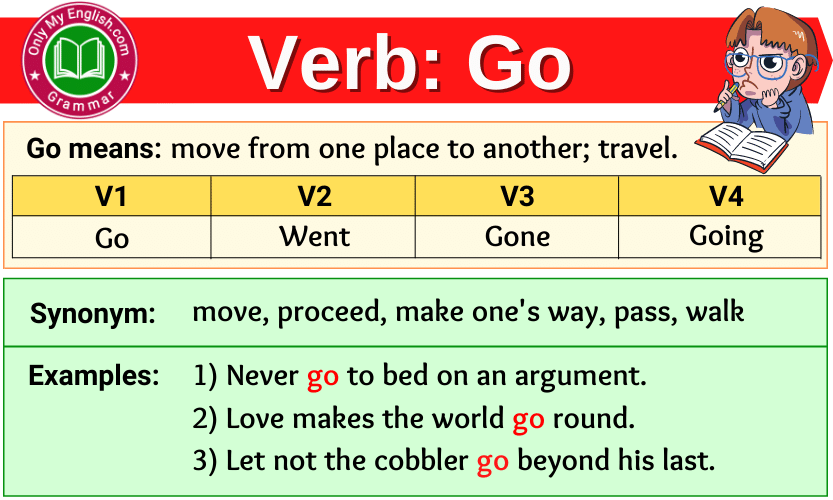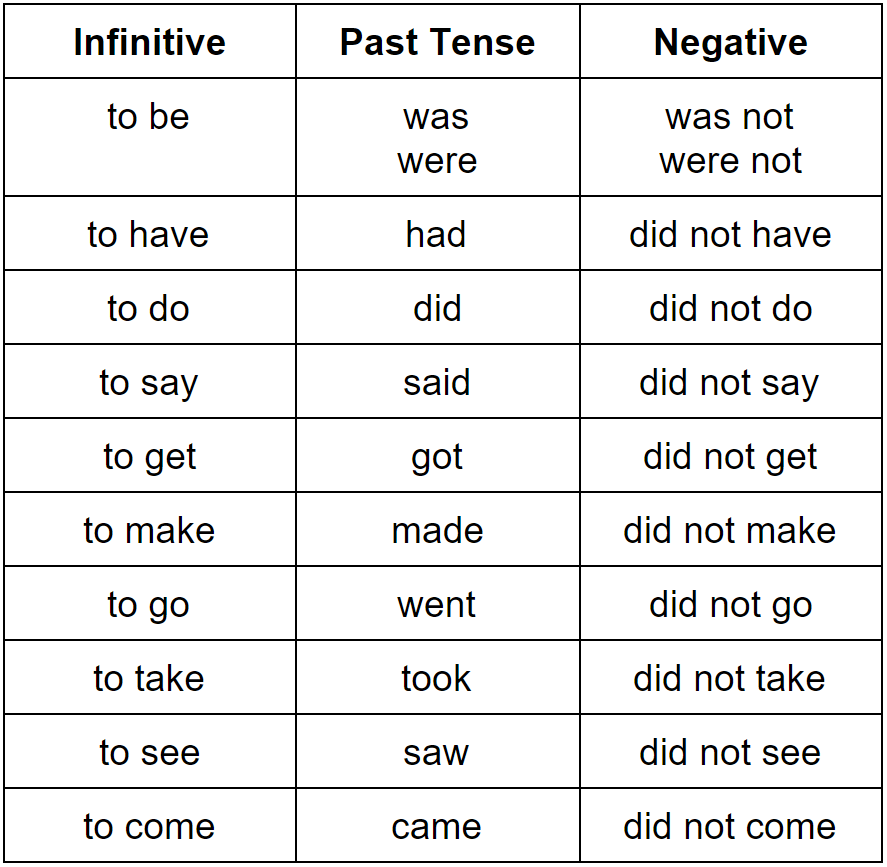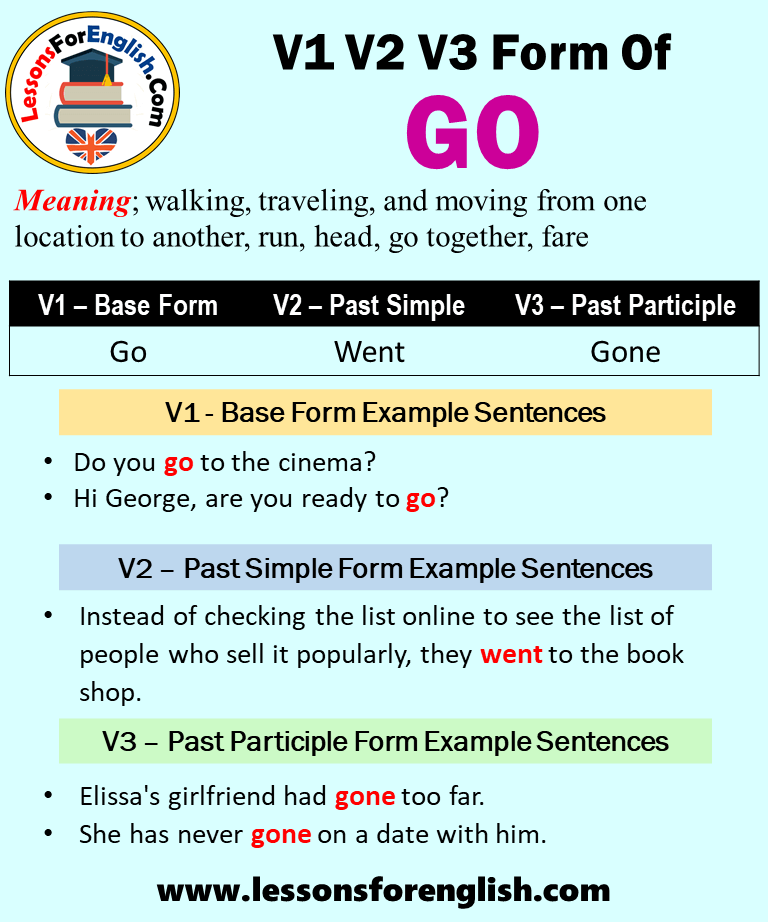PPT Grammar Power 8 PowerPoint Presentation, free download ID2104448

Simple Past Tense of Go RyliehasShort
The simple past tense shows that you are talking about something that has already happened. Unlike the past continuous tense, which is used to talk about past events that happened over a period of time, the simple past tense indicates that the action occurred at a certain time and then was completed.

Simple Past Tense Definition & Useful Examples in English ESL Grammar
Go - English Grammar Today - a reference to written and spoken English grammar and usage - Cambridge Dictionary

PPT Grammar Power 8 PowerPoint Presentation, free download ID2104448
Verb Tenses Past simple — go in past simple went (V2) . Future simple — go in future simple is go (will + V1) . Present Perfect — go in present perfect tense is gone (have/has + V3) . Past Perfect — go in past perfect tense is gone (had + V3) . go regular or irregular verb? 👉 Is 'go' a regular or irregular verb? The verb 'go' is irregular verb.

Go Verb Forms Past Tense & Past Participle »
definition in Spanish in French in Italian Indicative Perfect tenses Continuous (progressive) and emphatic tenses Compound continuous (progressive) tenses Conditional Imperative Subjunctive Note: One may encounter the archaic present tense forms thou goest and s/he goeth. *Blue letters in conjugations are irregular forms. ( example)

Go back Past Simple in English, Simple Past Tense of Go back, Past
Grind. Grow. Hang. Have. Went is the past tense of go. Gone is the past participle of go. Go past form, verb forms, v1v2v3, Infinitive.

Past Simple Tense Verb "to be" Present tense verbs, Simple past tense
The past tense of 'go' is 'went.'. It's an irregular verb, which means that it doesn't follow the standard rules for forming the past tense. Instead, you need to memorize the past tense form of 'go' separately. Here are some examples of 'go' in the past tense: I went to the store yesterday.

Go Past Simple, Past Participle, V1 V2 V3 Form of Go English Vocabs
Past participle gone Modelo : go Auxiliar : have, be Otras formas: not go Contracciones Publicidad Indicative Present I go you go he/she/it goes we go you go they go Preterite I went you went he/she/it went we went you went they went Present continuous I am going you are going he/she/it is going we are going you are going they are going

The past simple is the tense used to express situations, events and
Future perfect continuous. I will have been go ing. you will have been go ing. he will have been go ing. we will have been go ing. you will have been go ing. they will have been go ing.

Past simple
Simple past english went Past participle english gone More information Full conjugation of "to go" Translations for "to go" Full conjugation of "to go" Indicative Present I go you go he/she/it goes we go you go they go Present continuous

Simple Past TenseGrammar Rules Grammarly
used to describe events that started in the past and continue into the present or were recently completed, emphasizing their relevance to the present moment Go past tense Simple past tense of go used for events completed in the past Past continuous tense of go used to describe ongoing past events, often in relation to the occurrence of another.

grammar rules for simple past tense Archives English Study Here
The simple past tense, also known as the past simple, the past tense or the preterite, expresses completed actions in the recent and distant past. It is the basic past tense in English grammar. We form this tense with the past simple form of the main verb and did, the past simple form of the auxiliary verb do.

Past Tense Of Go Simple Past Tense Definition & Useful Examples in
Simple Past Tense He/She/It went. I went. You/We/They went. Past Continuous Tense He/She/It was going. I was going. You/We/They were going. Past Perfect Tense He/She/It had gone. I had gone. You/We/They had gone. Past Perfect Continuous Tense He/She/It had been going. I had been going. You/We/They had been going. Simple Future Tense

Go Past Simple, Simple Past Tense of Go, V1 V2 V3 Form Of Go Go means
Conclusion. Remember that "go" has two principal past tense forms: "went" and "gone.". We use "went" for simple past actions and "gone" with auxiliary verbs to form perfect tenses. Knowing when to use each form will enhance your English grammar skills and make your writing more precise.

Simple Past Tense
Past participle gone Model : go Auxiliary : have, be Other forms: not go Contractions Advertising Indicative Present I go you go he/she/it goes we go you go they go Preterite I went you went he/she/it went we went you went they went Present continuous I am going you are going he/she/it is going we are going you are going

Past Tense Of Go, Past Participle Form of Go, Go Went Gone V1 V2 V3
Simple past: went Irregular forms Auxilliary verb Spelling change Use contractions Indicative Present I go you go he/she/it goes we go they go you go Preterite Future Perfect Present Past Future Continuous Present Past Future Continuous Perfect Present Past Future Conditional Present I would go you would go he/she/it would go we would go

Past simple Interactive worksheet Simple past tense worksheet, Simple
The Verb "Go" in English Conjugation of "To Go" The verb "go" is an irregular verb. (This means that "go" does not form its simple past tense or its past participle by adding "-ed" or "-d" to the base form.) The Five Forms of "To Go" Example Sentences with To Go It's your go. Select the correct version of "to go": 1. I want to home. 2.